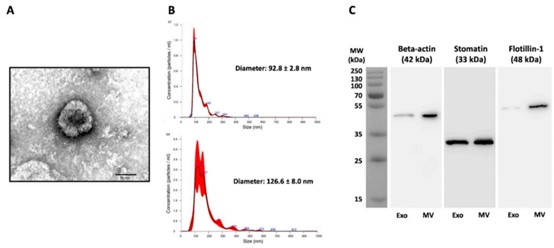Plasmodium-derived Exosome Research and Application
Plasmodium-derived exosomes have been found to mediate malaria parasites’ invasiveness and communication with various host systems. Moreover, it has been demonstrated that internalization of Plasmodium-derived exosomes can trigger innate immune responses and regulate the endothelial cell barrier. Creative Biolabs can provide comprehensive research services on Plasmodium-derived exosomes, advancing projects related to pathogenesis and therapeutic strategies for malaria parasites.
Strategies for Obtaining Plasmodium-derived Exosomes
-
Culture malaria parasites in human erythrocytes based on standard methods.
-
Change media and monitor parasite growth on a daily basis.
-
Collect culture supernatants separately for early Plasmodium falciparum in the ring form to mid-trophozoite, as well as for late Plasmodium falciparum in the mid-trophozoite to early-ring form.
-
Centrifuge parasite supernatants at low speed to remove erythrocytes, then filter.
-
Ultracentrifuge to obtain early and late Plasmodium-derived microvesicles, respectively.
-
Filter and ultracentrifuge the supernatant further to obtain early and late Plasmodium-derived exosomes, respectively.
Research on Plasmodium-derived Exosomes
Characterization of Plasmodium-derived extracellular vesicle subpopulations.
Plasmodium-derived microvesicles exhibited greater size compared to Plasmodium-derived exosomes, while both subpopulations expressed markers, including the erythrocyte membrane integrative protein stomatin, as well as the cytoplasmic proteins β-actin and flotillin-1.
|
Comparing the proteomes of multiple types of Plasmodium-derived exosomes.
-
Proteomic profiling revealed that Plasmodium-derived exosomes contain both erythrocyte-specific proteins such as acetylcholinesterase and thioredoxin reductase as well as exosome-specific proteins such as filamin A and albumin.
-
The human proteins harbored in extracellular vesicles of Malaria parasites origin are specific for the type of microvesicles and exosome subpopulations, but not for the early and late parasitic development stages.
-
The human proteome and the Plasmodium falciparum proteome carried within extracellular vesicles isolated from different Plasmodium falciparum strains were identified to be highly conserved.
|
Examination of Plasmodium-derived exosomes involved in the parasite invasion process.
Protein profiling revealed that Plasmodium-derived exosome carrying virulence proteins such as merozoite surface protein-1, reticulocyte binding protein homologue 1, and apical membrane antigen 1 involved in Plasmodium falciparum invasion and parasite development. Further assessment of invasion in erythrocytes showed that Plasmodium-derived exosome treatment attenuated the invasion efficiency of Plasmodium falciparum.
|
 Fig. 1 Characterization of Plasmodium-derived extracellular vesicle subpopulations.1
Fig. 1 Characterization of Plasmodium-derived extracellular vesicle subpopulations.1
Component profiling of Plasmodium-derived extracellular vesicles revealed the characteristics of different subpopulations and growth stages of Plasmodium exosomes in terms of physical properties, protein content, and biological functions, facilitating an in-depth understanding of the mechanisms by which malaria parasites utilize their powerful exosomal pathways to communicate, invade hosts, and develop drug resistance. Creative Biolabs is committed to providing reliable services for the study of Plasmodium-derived exosomes. Please contact us with interest.
Reference
-
Vimonpatranon, Sinmanus, et al. "Extracellular vesicles derived from early and late stage plasmodium falciparum-infected red blood cells contain invasion-associated proteins." Journal of Clinical Medicine 11.14 (2022): 4250.
For Research Use Only. Cannot be used by patients.
Related Services:

 Fig. 1 Characterization of Plasmodium-derived extracellular vesicle subpopulations.1
Fig. 1 Characterization of Plasmodium-derived extracellular vesicle subpopulations.1









